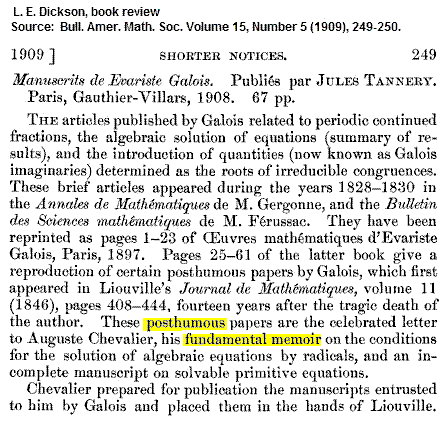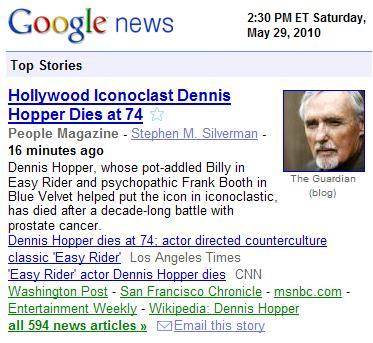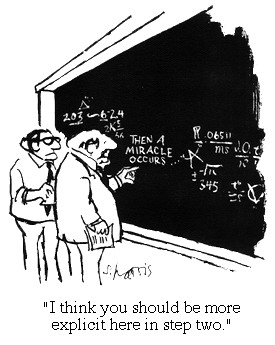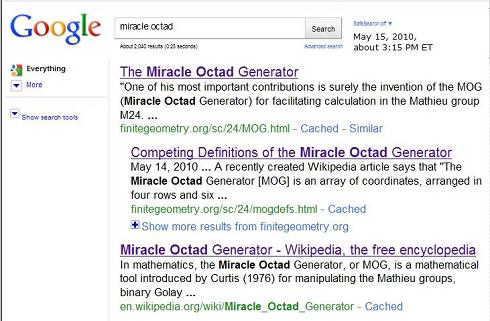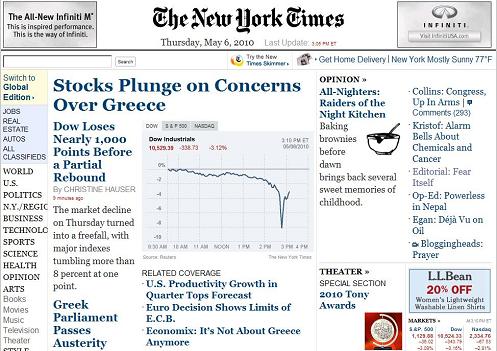(Continued from Epiphany 2010)
Friday, June 4, 2010
Brightness at Noon
For the Mothers of Invention
A Better Story
Continued from May 8
(Feast of Saint Robert Heinlein)
“Wells and trees were dedicated to saints. But the offerings at many wells and trees were to something other than the saint; had it not been so they would not have been, as we find they often were, forbidden. Within this double and intertwined life existed those other capacities, of which we know more now, but of which we still know little– clairvoyance, clairaudience, foresight, telepathy.”
— Charles Williams, Witchcraft, Faber and Faber, London, 1941
Why "Saint" Robert? See his accurate depiction of evil– the Eater of Souls in Glory Road.
For more on Williams's "other capacities," see Heinlein's story "Lost Legacy."
A related story– Fritz Leiber's "The Mind Spider." An excerpt:
The conference—it was much more a hyper-intimate
gabfest—proceeded.
"My static box bugged out for a few ticks this morning,"
Evelyn remarked in the course of talking over the
trivia of the past twenty-four hours.
The static boxes were an invention of Grandfather
Horn. They generated a tiny cloud of meaningless brain
waves. Without such individual thought-screens, there was
too much danger of complete loss of individual personality
—once Grandfather Horn had "become" his infant daughter
as well as himself for several hours and the unfledged
mind had come close to being permanently lost in its own
subconscious. The static boxes provided a mental wall be-
- hind which a mind could safely grow and function, similar
to the wall by which ordinary minds are apparently
always enclosed.
In spite of the boxes, the Horns shared thoughts and
emotions to an amazing degree. Their mental togetherness
was as real and as mysterious—and as incredible—as
thought itself . . . and thought is the original angel-cloud
dancing on the head of a pin. Their present conference
was as warm and intimate and tart as any actual family
gathering in one actual room around one actual table.
Five minds, joined together in the vast mental darkness
that shrouds all minds. Five minds hugged together for
comfort and safety in the infinite mental loneliness that
pervades the cosmos.
Evelyn continued, "Your boxes were all working, of
course, so I couldn't get your thoughts—just the blurs of
your boxes like little old dark grey stars. But this time
if gave me a funny uncomfortable feeling, like a spider
Crawling down my—Grayl! Don't feel so wildly! What
Is it?”
Then… just as Grayl started to think her answer…
something crept from the vast mental darkness and infinite
cosmic loneliness surrounding the five minds of the
Horns.
Grayl was the first to notice. Her panicky thought had
ttie curling too-keen edge of hysteria. "There are six of
us now! There should only be five, but there are six.
Count! Count, I tell you! Six!"
To Mort it seemed that a gigantic spider was racing
across the web of their thoughts….
See also this journal on May 30– "720 in the Book"– and on May 31– "Memorial for Galois."
("Obnoxious nerds"— a phrase Martin Gardner recently applied to Galois— will note that 720
Thursday, June 3, 2010
Trickster
Margaret Atwood (pdf) on Lewis Hyde’s
Trickster Makes This World: Mischief, Myth, and Art –
“Trickster,” says Hyde, “feels no anxiety when he deceives…. He… can tell his lies with creative abandon, charm, playfulness, and by that affirm the pleasures of fabulation.” (71) As Hyde says, “… almost everything that can be said about psychopaths can also be said about tricksters,” (158), although the reverse is not the case. “Trickster is among other things the gatekeeper who opens the door into the next world; those who mistake him for a psychopath never even know such a door exists.” (159)
What is “the next world”? It might be the Underworld….
The pleasures of fabulation, the charming and playful lie– this line of thought leads Hyde to the last link in his subtitle, the connection of the trickster to art. Hyde reminds us that the wall between the artist and that American favourite son, the con-artist, can be a thin one indeed; that craft and crafty rub shoulders; and that the words artifice, artifact, articulation and art all come from the same ancient root, a word meaning to join, to fit, and to make. (254) If it’s a seamless whole you want, pray to Apollo, who sets the limits within which such a work can exist. Tricksters, however, stand where the door swings open on its hinges and the horizon expands: they operate where things are joined together, and thus can also come apart.
See also George P. Hansen on Martin Gardner, Trickster.
Wednesday, June 2, 2010
The Harvard Style
"I wonder if there's just been a critical mass
of creepy stories about Harvard
in the last couple of years…
A kind of piling on of
nastiness and creepiness…"
– Margaret Soltan, October 23, 2006
Harvard University Press
on Facebook—
 |
|
| http://ping.fm/YrgOh | |
The book that the late Gardner was reviewing
was published in April by Harvard University Press.
If Gardner's remark were true,
Galois would fit right in at Harvard. Example—
The Harvard math department's pie-eating contest—

Rite of Passage
Wikipedia—
"On June 2, Évariste Galois was buried in a common grave of the Montparnasse cemetery whose exact location is unknown."
Évariste Galois, Lettre de Galois à M. Auguste Chevalier—
Après cela, il y aura, j'espère, des gens qui trouveront leur profit à déchiffrer tout ce gâchis.
(Later there will be, I hope, some people who will find it to their advantage to decipher all this mess.)
Martin Gardner on the above letter—
"Galois had written several articles on group theory, and was merely annotating and correcting those earlier published papers."
– The Last Recreations, by Martin Gardner, published by Springer in 2007, page 156.
Tuesday, June 1, 2010
The Gardner Tribute
"It is a melancholy pleasure that what may be [Martin] Gardner’s last published piece, a review of Amir Alexander’s Duel at Dawn: Heroes, Martyrs & the Rise of Modern Mathematics, will appear next week in our June issue."
– Roger Kimball of The New Criterion, May 23, 2010.
The Gardner piece is now online. It contains…
|
Gardner's tribute to Galois—
"Galois was a thoroughly obnoxious nerd,
suffering from what today would be called a 'personality disorder.' His anger was paranoid and unremitting." |
Annals of Art History
On Misplaced Concreteness—
An excerpt from China and Vietnam: The Politics of Asymmetry, by Brantly Womack (Cambridge U. Press, 2006)—
The book is intended to be a contribution to the general theory of international relations as well as to the understanding of China and Vietnam, but I give greater priority to “the case” rather than to the theory. This is a deliberate methodological decision. As John Gerring has argued, case studies are especially appropriate when exploring new causal mechanisms.2 I would argue more broadly that the “case” is the reality to which the theory is secondary. In international relations theory, “realism” is often contrasted to “idealism,” but surely a more basic and appropriate meaning of “realism” is to give priority to reality rather than to theory. The philosopher Alfred North Whitehead defined the Fallacy of Misplaced Concreteness as “neglecting the degree of abstraction involved when an actual entity is considered merely so far as it exemplifies certain categories of thought.”3 In effect, the concept is taken as the concrete reality, and actual reality is reduced to a mere appendage of data. Misplaced Concreteness may well be the cardinal sin of modern social science. It is certainly pandemic in international relations theory, where a serious consideration of the complexities of real political situations is often dismissed as mere “area studies.” Like the Greek god Anteus who was sustained by touching his Mother Earth, theory is challenged and rejuvenated by planting its feet in thick reality.
2 John Gerring, "What Is a Case Study and What Is It Good For?"
American Political Science Review 98:2 (May 2004), pp. 341-54
3 Alfred North Whitehead, Process and Reality
(New York: Harper, 1929), p. 11
Remarks—
"Whitehead defined the Fallacy of Misplaced Concreteness…."
The phrase "misplaced concreteness" occurs in the title of a part of an exhibition, "Theme and Variations," by artist Josefine Lyche (Oslo, 2009). I do not know what Lyche had in mind when she used the phrase. A search for possible meanings yielded the above passage.
"In international relations theory, “realism” is often contrasted to “idealism….”
For a more poetic look at "realism" and "idealism" and international relations theory, see Midsummer Eve's Dream.
Contra Harvard
Today is commencement day at Princeton.
Sunday's A Post for Galois was suggested, in part, by the fact that the founder and CEO of Amazon.com was that day's Princeton baccalaureate speaker. The Galois post linked to the Amazon reviews of one Christopher G. Robinson, a resident of Cambridge, Mass., whose Amazon book list titled "Step Right Up!" reflects a continuing libertine tradition at Harvard.
For Princeton's commencement day, it seems fitting to cite another Amazon document that reflects the more conservative values of that university.
I recommend the review Postmodern Pythagoras, by Matthew Milliner. Milliner is, in his own words, "an art history Ph.D. candidate at Princeton University."
See also Milliner's other reviews at Amazon.com.
"For every kind of libertine,
there is a kind of cross."
– Saying adapted from Pynchon
Monday, May 31, 2010
Memorial for Galois
… and for Louise Bourgeois
"The épateurs were as boring as the bourgeois,
two halves of one dreariness."
– D. H. Lawrence, The Plumed Serpent
Sunday, May 30, 2010
A Post for Galois
Evariste Galois, 1811-1832 (Vita Mathematica, V. 11)
- Paperback: 168 pages
- Publisher: Birkhäuser Basel; 1 edition (December 6, 1996)
- Language: English
- ISBN-10: 3764354100
- ISBN-13: 978-3764354107
- Product Dimensions: 9.1 x 6 x 0.4 inches
- Shipping Weight: 9.1 ounces
- Average Customer Review: 5.0 out of 5 stars (1 customer review)
- Amazon Bestsellers Rank: #933,939 in Books
Awarded 5 stars by Christopher G. Robinson (Cambridge, MA USA).
See also other reviews by Robinson.
Galois was shot in a duel on today's date, May 30, in 1832. Related material for those who prefer entertainment to scholarship—
"It is a melancholy pleasure that what may be [Martin] Gardner’s last published piece, a review of Amir Alexander’s Duel at Dawn: Heroes, Martyrs & the Rise of Modern Mathematics, will appear next week in our June issue." –Roger Kimball of The New Criterion, May 23, 2010.
Today is, incidentally, the feast day of St. Joan of Arc, Die Jungfrau von Orleans. (See "against stupidity" in this journal.)
720 in the Book
"Princeton's Baccalaureate service is an end-of-the-year ceremony focused on members of the senior class. It includes prayers and readings from various religious and philosophical traditions."
One such tradition— the TV series "Lost."
Another— the Pennsylvania Lottery—

For some context,
see May 6, 2010.
See also this journal's post
"The Omen" on the date 6/6/6.
Trilateral

"Greater East Asia" (大東亜 Dai-tō-a)
was a Japanese term
(banned during the post-war Occupation)
referring to Far East Asia. –Wikipedia

Related historical remarks from Wikipedia—
"From the Japanese point of view, one common principal reason stood behind both forming the Greater East Asia Co-Prosperity Sphere and initiating war with the Allies: Chinese markets. Japan wanted their 'paramount relations' in regard to Chinese markets acknowledged by the U.S. government. The U.S., recognizing the abundance of potential wealth in these markets, refused to let the Japanese have an advantage in selling to China."
"Shine on, shine on,
there is work to be done
in the dark before the dawn."

"The exhibition title Theme and Variations
hints at the analytical-intellectual undertone
Josefine Lyche takes this time, but
not without humorous touches."
Saturday, May 29, 2010
An Icon for Hopper
Packed
Significant Passage:
On the Writing Style of Visual Thinkers
"The words are filled with unstated meaning.
They are (the term is Ricoeur's) 'packed'
and need unpacking." –Gerald Grow
From the date of Ricoeur's death,
May 20, 2005—
“Plato’s most significant passage
may be found in Phaedrus 265b…."
|
With a little effort, cross-referenced." – Opening sentence
|
Mozart's K 265 is variations on the theme
now known as "Twinkle, Twinkle, Little Star."
For darker variations on the Twinkle theme,
see the film "Joshua" and Martin Gardner's
Annotated Alice (Norton, 2000, pp. 73-75).

For darker variations on the asterisk theme,
see Darkness Visible (May 25)
and Vonnegut's Asterisk.
Friday, May 28, 2010
Multispeech for Oxford
Happy Birthday,
Carey Mulligan

Star of "An Education"
In "An Education," Mulligan's character
applies for admission to Oxford.
Today's New York Times:
| Education »
Oxford Tradition Comes to This: ‘Death’ (Expound) |
Related material:
|
Such words arrive on the page like suitcases at the baggage claim: You know there is something in them and they have travelled far, but you cannot tell what the writer means. The words are filled with unstated meaning. They are (the term is Ricoeur's) "packed" and need unpacking. This method of using language, however, is not always a defect; radiantly evocative words have long been the language of myth, mysticism, and love. Also, in earlier centuries, educated readers expected to interpret writing on several different levels at once (e.g., literal, allegorical, moral, and anagogical or spiritual), so that multiple meanings were the norm. This was before the era of clear, expository, fully-explicit prose. Visual thinkers are accustomed to their own kind of interpreting; the very act of visual perception, as Gregory (1966, 1970) and Gombrich (1959) have shown, is interpretive. When oral thinkers leave you to guess at something they have written, it is usually something that would have been obvious had the writing been a conversation. Such is not the case with visual thinkers, even whose spoken words can be mysterious references to visual thoughts invisible to anyone but the thinker. Writing done in this "packed" manner makes more sense when read as poetry than when read as prose. References: Gombrich, E. H. (1959). Art and Illusion: A Study in the Psychology of Pictorial Representation. London: Phaidon. Gregory, R. L. (1966). Eye and Brain: The Psychology of Seeing. New York: McGraw-Hill. Gregory, R. L. (1970). The Intelligent Eye. New York: McGraw-Hill. – "Stacking, Packing, and Enfolding Words," by Gerald Grow in "The Writing Problems of Visual Thinkers" |
Those wishing to emulate Mulligan's
character in "An Education" might,
having read the Times article above,
consult this journal's post of May 17,
"Rolling the Stone."
That post contains the following
image from the Times—
May 17 was, by the way, the day
that R. L. Gregory, author of
The Intelligent Eye, died.
Multispeech
For Memorial Day Weekend:
See also Time and Chance: Log24 Posts of Oct. 24, 2006*, which include a link to the work of Msgr.✝ Robert Sokolowski of the Catholic University of America.
* For the connection between Finnegans Wake and the date October 24, 2006, see Polyglot Joyce, p. 223, and Phrase Finder.
✝ From the posts of Saturday, May 22— "The Lyche Gate was the covered gateway at the entrance of the church yard, where the corpse was rested until the priest issued from the church to meet the procession."
– Ancient English Ecclesiastical Architecture, by Frank Wills, published by Stanford and Swords, 1850
Thursday, May 27, 2010
Masks
Charles Isherwood on the death last Saturday of a fellow theater critic—
"...as it happened, I heard about his death just as I was entering the Lunt-Fontanne to see 'The Addams Family.' For a second time. By myself.
Now, there are happier ways to spend a Saturday night than attending a show you didn’t particularly like for the second time, by yourself. (Long story.) But then there’s no happy way to spend the night a friend dies."
For what it's worth— night thoughts from this journal, Saturday night to Sunday morning—
- Annals of Conceptual Art (2:02 AM ET Sunday)
- Annals of Philosophy (3:33 AM ET Sunday)
- Sunday School (9:00 AM ET Sunday)
From "Sunday School"—
"Nine tailors make a man."
– Dorothy Sayers
A Gathering for Gardner
"You ain't been blue; no, no, no.
You ain't been blue,
Till you've had that mood indigo."
– Song lyrics, authorship disputed
Indigo (web color) (#4B0082)
"Pigment indigo (web color indigo) represents
the way the color indigo was always reproduced
in pigments, paints, or colored pencils in the 1950s."
Related mythology:
Indigo Children and the classic
1964 film Children of the Damned
Related non-mythology:
Wednesday, May 26, 2010
Tuesday, May 25, 2010
Sisteen
"Nuvoletta in her lightdress, spunn of sisteen shimmers,
was looking down on them, leaning over the bannistars….
Fuvver, that Skand, he was up in Norwood's sokaparlour…."
– Finnegans Wake
To counteract the darkness of today's 2:01 AM entry—
Part I— Artist Josefine Lyche describes her methods—
A— "Internet and hard work"
B— "Books, both fiction and theory"
Part II— I, too, now rely mostly on the Internet for material. However, like Lyche, I have Plan B— books.
Where I happen to be now, there are piles of them. Here is the pile nearest to hand, from top to bottom.
(The books are in no particular order, and put in the same pile for no particular reason.)
- Philip Rieff— Sacred Order/Social Order, Vol. I: My Life Among the Deathworks
- Dennis L. Weeks— Steps Toward Salvation: An Examination of Coinherence and Substitution in the Seven Novels of Charles Williams
- Erwin Panofsky— Idea: A Concept in Art Theory
- Max Picard— The World of Silence
- Walter J. Ong, S. J.— Hopkins, the Self, and God
- Richard Robinson— Definition
- X. J. Kennedy and Dana Gioia, eds.— An Introduction to Poetry
- Richard J. Trudeau— The Non-Euclidean Revolution
- William T. Noon, S. J.— Joyce and Aquinas
- Munro Leaf— Four-and-Twenty Watchbirds
- Jane Scovell— Oona: Living in the Shadows
- Charles Williams— The Figure of Beatrice
- Francis L. Fennell, ed.— The Fine Delight: Centenary Essays on the Poetry of Gerard Manley Hopkins
- Hilary Putnam— Renewing Philosophy
- Paul Tillich— On the Boundary
- C. S. Lewis— George MacDonald
Lyche probably could easily make her own list of what Joyce might call "sisteen shimmers."
ART WARS continued
Darkness Visible
The inevitable tribute to Martin Gardner
has now appeared at the AMS website—
Related Imagery—
The following is an image from Saturday morning—

See also Art Wars and
Mathematics and Narrative.
Monday, May 24, 2010
Finale
The weekend's posts in this journal coincided,
more or less, with the finale of the TV series "Lost."
Recalling each story brings to mind
the subtitle of Heinrich Zimmer's classic
The King and the Corpse —
Tales of the Soul's Conquest of Evil.
Here, in the spirit of "The Fifth Element," is a
brief graphic summary of such a conquest—
The Soul
Evil
(from Saturday morning)
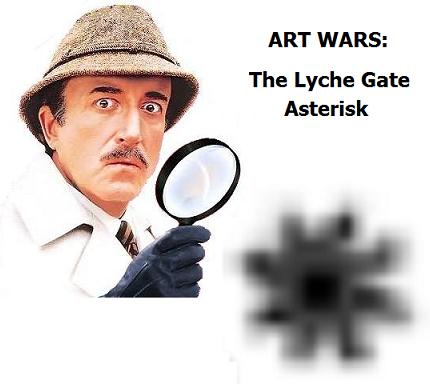
Sunday, May 23, 2010
For Your Consideration –
Cannes Festival Readies for Awards Night
Uncertified Copy
The pictures in the detail are copies of
figures created by S. H. Cullinane in 1986.
They illustrate his model of hyperplanes
and points in the finite projective space
known as PG(3,2) that underlies
Cullinane's diamond theorem.
The title of the pictures in the detail
is that of a film by Burkard Polster
that portrays a rival model of PG(3,2).
The artist credits neither Cullinane nor Polster.
Sunday School
"Mathematics is forever."
– Gian-Carlo Rota
"Nine is a very powerful
Nordic number."
– Katherine Neville
"Nine tailors make a man."
– Dorothy Sayers
Annals of Philosophy
Annals of Conceptual Art
Josefine Lyche's
"Theme and Variations" (Oslo, 2009)—
Some images in reply—
Click on images for further details.
"In the name of the former
and of the latter
and of their holocaust.
Allmen."
Saturday, May 22, 2010
In the Details
Today's New York Times—
|
"…there were fresh questions about whether the intelligence overhaul that created the post of national intelligence director was fatally flawed, and whether Mr. Obama would move gradually to further weaken the authorities granted to the director and give additional power to individual spy agencies like the . Mr. Blair and each of his predecessors have lamented openly that the intelligence director does not have enough power to deliver the intended shock therapy to America’s byzantine spying apparatus." |
Catch-22 in Doonesbury today—

From Log24 on Jan. 5, 2010—
Artifice of Eternity—
A Medal
In memory of Byzantine scholar Ihor Sevcenko,
who died at 87 on St. Stephen's Day, 2009–
Thie above image results from a Byzantine
meditation based on a detail in the previous post—

"This might be a good time to
call it a day." –Today's Doonesbury
"TOMORROW ALWAYS BELONGS TO US"
Title of an exhibition by young Nordic artists
in Sweden during the summer of 2008.
The exhibition included, notably, Josefine Lyche.
But seriously…
Lyche Gate

| Title | Ancient English ecclesiastical architecture and its principles, applied to the wants of the church at the present day American culture series II ; 029.008 |
| Author | Frank Wills |
| Publisher | Stanford and Swords, 1850 |
| Original from | the New York Public Library |
| Digitized | Apr 24, 2008 |
| Length | 120 pages |
| Subjects | Architecture, Medieval Church architecture |
Art Space
From an interview with artist Josefine Lyche (see previous post) dated March 11, 2009—
- Can you name a writer or book, fiction or theory that has inspired your works?
- Right now I am reading David Foster Wallace, which is great and inspiring. Others would be Aleister Crowley, Terence McKenna, James Joyce, J.L Borges, J.D Ballard, Stanislaw Lem, C. S. Lewis and Plato to mention some. Books, both fiction and theory are a great part of my life and work.
This journal on the date of the interview had a post about a NY Times story, ”Paris | A Show About Nothing."
Related images—
|
Pictorial version |
|
“Space: what you damn well have to see.”
– James Joyce, Ulysses
Friday, May 21, 2010
The Oslo Version
From an art exhibition in Oslo last year–
The artist's description above is not in correct left-to-right order.
Actually the hyperplanes above are at left, the points at right.
Compare to "Picturing the Smallest Projective 3-Space,"
a note of mine from April 26, 1986—
Click for the original full version.
Compare also to Burkard Polster's original use of
the phrase "the smallest perfect universe."
Polster's tetrahedral model of points and hyperplanes
is quite different from my own square version above.
See also Cullinane on Polster.
Here are links to the gallery press release
and the artist's own photos.
Thursday, May 20, 2010
The Prize
Update of NY Times Art & Design
(See today's earlier posts
Annals of Conceptual Art and View.)

The architecture award ceremony was
at Ellis Island on Monday evening.
Related material:
View
Pictorial version
of Hexagram 20,
Contemplation (View)
Related material:
A Handful of Dust
by J. G. Ballard
Annals of Conceptual Art
New York Times Art & Design section, morning of Thursday, May 20, 2010—
Arakawa, Whose Art Tried to Halt Aging, Dies at 73
By FRED A. BERNSTEIN
Published: May 19, 2010
Arakawa, a Japanese-born conceptual artist and designer, who with his wife, Madeline Gins, explored ideas about mortality by creating buildings meant to stop aging and preclude death, died Tuesday in Manhattan. He was 73.
He had been hospitalized for a week, said Ms. Gins, who declined to give the cause of death.
Perhaps it was white space—
 |
Wednesday, May 19, 2010
Preforming
Photo caption in NY Times today— a pianist "preforming" in 1967. (See today's previous post.)
The pianist's life story seems in part to echo that of Juliette Binoche in the film "Bleu." Binoche appeared in this journal yesterday, before I had seen the pianist in today's Times obituaries. The Binoche appearance was related to the blue diamond in the film "Duelle " (Tuesday morning's post) and the saying of Heraclitus "immortals mortal, mortals immortal" (Tuesday afternoon's post).
This somewhat uncanny echo brings to mind Nabokov—
Life Everlasting—based on a misprint!
I mused as I drove homeward: take the hint,
And stop investigating my abyss?
But all at once it dawned on me that this
Was the real point, the contrapuntal theme;
Just this: not text, but texture; not the dream
But topsy-turvical coincidence,
Not flimsy nonsense, but a web of sense.
Whether sense or nonsense, the following quotation seems relevant—
"Archetypes function as living dispositions, ideas in the Platonic sense, that preform and continually influence our thoughts and feelings and actions." –C.G. Jung in Four Archetypes: Mother, Rebirth, Spirit, Trickster, the section titled "On the Concept of the Archetype."
That section is notable for its likening of Jungian archetypes to Platonic ideas and to axial systems of crystals. See also "Cubist Tune," March 18 —
Blue Note à Quatre
The Concert à Quatre "was Messiaen's last work, left unfinished on his desk at his death. His widow undoubtedly followed his wishes and style in completing the orchestration." –Leslie Gerber
Related material:
See also yesterday's Stone Junction, this morning's note on Heidegger 's Geviert, and Moulin Bleu from Beethoven's birthday, 2003—
Juliette Binoche in "Bleu"
Mathematics and Gestalt
"We acknowledge a theorem's beauty
when we see how the theorem 'fits'
in its place, how it sheds light around itself,
like a Lichtung, a clearing in the woods."
– Gian-Carlo Rota, Indiscrete Thoughts
Here Rota is referring to a concept of Heidegger.
Some context—
"Gestalt Gestell Geviert: The Way of the Lighting,"
by David Michael Levin in The Philosopher's Gaze
Tuesday, May 18, 2010
Philosophy: An Example

"This is in point of form Heraclitus' masterpiece,
the most perfectly symmetrical of all the fragments."
Stone Junction*
The Philosophers' Stone
according to
The New York Times—

Related material
from French cinema—
"a 'non-existent myth' of a battle between
goddesses of the sun and the moon
for a mysterious blue diamond
that has the power to make
mortals immortal and vice versa."
See also


* The title is a reference to Jim Dodge's 1989 novel Stone Junction: An Alchemical Potboiler.
Monday, May 17, 2010
Round Midnight
A Google search suggested by Dexter Gordon's "Round Midnight" yields…
-
m759 on Xanga – Weblog – Archives – May 2007
Pope Benedict XVI on Sunday in Brazil "Dare to struggle, dare to win!" "Dare to guzzle Gordon's gin." — dialogue from Masks of the Illuminati …
m759.xanga.com/archives/2007/5/ – Cached -
тексты,статьи,артефакты эпохи венца бредоносия и трансмутации …
4 posts - 1 author - Last post: Aug 19, 2009
Dare to guzzle Gordon's gin, Joyce added. Je suis Bovary, Flaubert said looking embarrassed. Je suis Molly Bloom, Joyce said unembarrassed. …
psytribe.ru/index.php?topic=14001.0
May 18 update — The Russian link has been replaced by a link to a cached copy of the relevant content.
Rolling the Stone
A new NY Times column:
Today's New York Times
re-edited for philosophers:
See also
John Baez's paper
Duality in Logic and Physics
(for a May 29 meeting at Oxford),
Lubtchansky's Key, with its links
to Duelle (French, f. adj., dual)
and Art Wars for Trotsky's Birthday.
Sunday, May 16, 2010
Saturday, May 15, 2010
For St. Cecilia
In memory of David Randolph, longtime director of Manhattan's St. Cecilia Chorus. Randolph died at 95 on May 12. (See May 12's "Soul Song.")
A book by Randolph and other remarks
related to St. Cecilia, whose
feast day is November 22—

Friday, May 14, 2010
Competing MOG Definitions
A recently created Wikipedia article says that "The Miracle Octad Generator [MOG] is an array of coordinates, arranged in four rows and six columns, capable of describing any point in 24-dimensional space…." (Clearly any array with 24 parts is so capable.) The article ignores the fact that the MOG, as defined by R.T. Curtis in 1976, is not an array of coordinates, but rather a picture of a correspondence between two sets, each containing 35 structures. (As a later commentator has remarked, this correspondence is a well-known one that preserves a certain incidence property. See Eightfold Geometry.)
From the 1976 paper defining the MOG—
"There is a correspondence between the two systems of 35 groups, which is illustrated in Fig. 4 (the MOG or Miracle Octad Generator)." —R.T. Curtis, "A New Combinatorial Approach to M24," Mathematical Proceedings of the Cambridge Philosophical Society (1976), 79: 25-42

Curtis's 1976 Fig. 4. (The MOG.)
The Wikipedia article, like a similar article at PlanetMath, is based on a different definition, from a book first published in 1988—

I have not seen the 1973 Curtis paper, so I do not know whether it uses the 35-sets correspondence definition or the 6×4 array definition. The remarks of Conway and Sloane on page 312 of the 1998 edition of their book about "Curtis's original way of finding octads in the MOG [Cur2]" indicate that the correspondence definition was the one Curtis used in 1973—

Here the picture of "the 35 standard sextets of the MOG"
is very like (modulo a reflection) Curtis's 1976 picture
of the MOG as a correspondence between two 35-sets.
A later paper by Curtis does use the array definition. See "Further Elementary Techniques Using the Miracle Octad Generator," Proceedings of the Edinburgh Mathematical Society (1989) 32, 345-353.
The array definition is better suited to Conway's use of his hexacode to describe octads, but it obscures the close connection of the MOG with finite geometry. That connection, apparent in the phrases "vector space structure in the standard square" and "parallel 2-spaces" (Conway and Sloane, third ed., p. 312, illustrated above), was not discussed in the 1976 Curtis paper. See my own page on the MOG at finitegeometry.org.
Wednesday, May 12, 2010
Soul Song
Today's top New York Times obituary
mentions Irving Berlin's 1919 tune
"A Pretty Girl Is Like a Melody."
("That's show business." — Berlin)
I prefer a different song —
Related material —
Tuesday, May 11, 2010
Lubtchansky’s Key
William Lubtchansky, a cinematographer, was born on October 26, 1937, and died on May 4, 2010.
Yesterday's post included an illustration from this journal on the date of his death.
Here is a Log24 entry from last year on the date of his birth—
| Monday, October 26, 2009 The Keys Enigma Related material: |
Clicking on the Shift Lock key leads to the following page—

–The Philosopher's Gaze,
by David Michael Levin,
University of California Press, 1999
Related images—
Detail from May 4 image:

Holocaust Museum, Washington, DC:

(http://www.scrapbookpages.com/USHMM/Exterior.html)
See also Lubtchansky's Duelle and
Art Wars for Trotsky's Birthday, 2003.
Monday, May 10, 2010
Requiem for Georgia Brown
Paul Robeson in
"King Solomon's Mines," 1937—
The image above is an illustration from
"Romancing the Hyperspace," May 4, 2010.
This illustration, along with Georgia Brown's
song from "Cabin in the Sky"—
"There's honey in the honeycomb"—
suggests the following picture.
"What might have been and what has been
Point to one end, which is always present."
– Four Quartets
Sunday, May 9, 2010
For Miss Prothero (and Dylan Thomas)
Friday's post "Religion at Harvard" continues…

This list may be of some use to
Rebecca Newberger Goldstein, who, like Prothero,
spoke recently at Harvard Book Store.
See also Rosalind Krauss on Grids,
An Education, and Plan 9 from Outer Space.
Readers more advanced than Harvard audiences
may wish to compare yesterday's linked-to story
"Loo Ree" with the works of Alison Lurie–
in particular, Imaginary Friends and Familiar Spirits.
Saturday, May 8, 2010
A Better Story –
Or, "Get me rewrite!"
Today's New York Times online–
Rebecca Newberger Goldstein imagines a story about academics discussing literary theory—
"Rumors had reached us of a doctrine called Theory emanating from distant corners of the university. We in the Department of Philosophy understood it immediately as a grand hoax. I will not dwell on my particular amusement, in which I was so tragically at odds with my collaborator, Theo Rhee….
… It was at this moment that Hans Furth appeared and ambled over…."
And thanks to Google Books, here he is—
"…I can imagine the decisive evolutionary beginnings of humans and societies… not in an adult version, but in the playful mentality of children…. An unlikely story? Perhaps. I am looking out for a better story."
– Hans G. Furth, Desire for Society: Children's Knowledge as Social Imagination, published by Springer, 1996, p. 181
As am I. (See previous post.) One possibility, from 1943— "Mimsy Were the Borogoves."
Another possibility, from 1953— not Theo Rhee, but rather "Loo Ree."
Friday, May 7, 2010
Religion at Harvard –
The Unreliable Narrator Meets the Unreliable Reader
Comment by John Farrier on a list of 42 contrived plot devices –
"My favorite is the Unreliable Reader — a counterpart to the Unreliable Narrator."
Vladimir Nabokov — "Examples are the stained-glass windows of knowledge."
- Harvard Registrar's Office –
2010 Spring Reading Period Ends– May 6 (Th).
- Press release about a Harvard Square event at 7 PM Thursday –
"Harvard Book Store is pleased to welcome religion scholar and bestselling author STEPHEN PROTHERO for a conversation about his new book, God Is Not One: The Eight Rival Religions That Run the World—And Why Their Differences Matter." ….
Prothero's book avoids "the naive equating of them all as merely different paths to the same summit."
- Harvard Crimson photo caption today –
"Religion scholar and bestselling author Stephen Prothero speaks at the Harvard Book Store last night about his new book 'God Is Not One' in which he seeks to demonstrate how differences in paths leading to the same destination can enrich, not prevent, dialogue and cooperation."
Thursday, May 6, 2010
Infinite Jest
Leg-Pulling
 |
"… to make the author manifestly unreliable"
Not to mention the reader.
Related material —
The Great Clooney

"If you can bounce high, bounce for her too."
Happy birthday, George.
Metamorphosis
From Google yesterday —
| A spring metamorphosis — Google’s new look 5/05/2010 09:00:00 AM Using Google today, you may have noticed that something feels slightly different — the look and feel of our search results have changed! Today’s metamorphosis responds to the increasing richness of the web and the increasing power of search — revealing search tools on the left and updating the visual look and feel throughout. |
For example…

A metaphor for "More" –

Mathematics and Narrative, continued…
The Unfolding
A post for Florencio Campomanes,
former president of the World Chess Federation.
Campomanes died at 83 in the Philippines
at 1:30 PM local time (1:30 AM Manhattan time)
on Monday, May 3, 2010.
From this journal on the date of his death —
"There is such a thing as a tesseract."
– Madeleine L'Engle
Image by Christopher Thomas at Wikipedia —
Unfolding of a hypercube and of a cube —


Related material from a story of the Philippines —
Wednesday, May 5, 2010
Symmetry and Parallelisms
From a post of Peter J. Cameron today —
"… I want to consider the question: What is the role of the symmetric group in mathematics? "
Cameron's examples include, notably, parallelisms of lines in affine spaces over GF(2).


